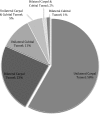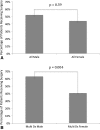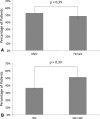Carpal and cubital tunnel syndrome: who gets surgery?
- PMID: 20049568
- PMCID: PMC2881989
- DOI: 10.1007/s11999-009-1210-2
Carpal and cubital tunnel syndrome: who gets surgery?
Abstract
Background: Despite the prevalence of carpal and cubital tunnel syndrome, and relief of symptoms following timely surgical release, it is unclear how nonclinical patient characteristics affect disease management.
Questions/purposes: We examined the effects of a variety of factors, such as age, gender, and socioeconomic status on the management of both carpal and cubital tunnel syndromes.
Patients and methods: We retrospectively reviewed the records of all 273 patients seen by two hand surgeons with a diagnosis of either carpal or cubital tunnel syndrome between January 2005 and January 2007. Demographic, clinical (diagnosis, treatment), and socioeconomic (insurance type, median income) information was collected. Census data (2000) were used to collect information on median household income. The average age was 52 years (range, 19-87 years), and 65% of the patients were women (n = 178). Eighteen patients had Workers Compensation. Of the 273 patients, 86 (32%) had two or more diagnoses.
Results: Among patients with carpal tunnel syndrome, there was a higher proportion of female patients compared to male patients (68% versus 32%); male patients with multiple neuropathies had higher rates of surgery than their female counterparts (63% versus 41%). Only increasing age was associated with increasing likelihood of surgery. Among multiple-diagnosis patients, those with Workers Compensation (n = 6) had higher wait times for surgery than their counterparts (n = 46) (126 days versus 26 days).
Conclusion: Patient age was the most important predictor of surgical release, and among those with multiple neuropathies, male patients were more likely to have surgery than female patients. Patients with Workers Compensation may experience long wait times to surgery.
Level of evidence: Level II, prognostic study. See Guidelines for Authors for a complete description of levels of evidence.
Figures







Similar articles
-
Surgical Demographics of Carpal Tunnel Syndrome and Cubital Tunnel Syndrome Over 5 Years at a Single Institution.J Hand Surg Am. 2017 Nov;42(11):929.e1-929.e8. doi: 10.1016/j.jhsa.2017.07.009. Epub 2017 Aug 12. J Hand Surg Am. 2017. PMID: 28811061
-
What Factors Are Associated With Revision Cubital Tunnel Release Within 3 Years?Clin Orthop Relat Res. 2023 Oct 1;481(10):1954-1962. doi: 10.1097/CORR.0000000000002629. Epub 2023 Mar 30. Clin Orthop Relat Res. 2023. PMID: 36999912 Free PMC article.
-
Muscle atrophy at diagnosis of carpal and cubital tunnel syndrome.J Hand Surg Am. 2007 Jul-Aug;32(6):855-8. doi: 10.1016/j.jhsa.2007.03.009. J Hand Surg Am. 2007. PMID: 17606066
-
Compression Neuropathies: Revisions and Managing Expectations.Hand Clin. 2023 Aug;39(3):389-401. doi: 10.1016/j.hcl.2023.02.009. Epub 2023 May 31. Hand Clin. 2023. PMID: 37453766 Review.
-
Treatment of Peripheral Nerve Compression Syndromes of the Upper Extremities: a Systematic Review.Z Orthop Unfall. 2023 Apr;161(2):182-194. doi: 10.1055/a-1498-3197. Epub 2021 Jul 14. Z Orthop Unfall. 2023. PMID: 34261169 English, German.
Cited by
-
Workers' compensation status: does it affect orthopaedic surgery outcomes? A meta-analysis.PLoS One. 2012;7(12):e50251. doi: 10.1371/journal.pone.0050251. Epub 2012 Dec 5. PLoS One. 2012. PMID: 23227160 Free PMC article.
-
Ultrasound Assessment of the Ulnar Nerve Around the Elbow and Diagnosis of Cubital Tunnel Syndrome, Clinical Outcomes.Hand (N Y). 2025 Jan;20(1):71-78. doi: 10.1177/15589447231187081. Epub 2023 Aug 3. Hand (N Y). 2025. PMID: 37533402 Free PMC article.
-
Age and socioeconomic status affect access to telemedicine at an urban level 1 trauma center.OTA Int. 2021 Oct 5;4(4):e155. doi: 10.1097/OI9.0000000000000155. eCollection 2021 Dec. OTA Int. 2021. PMID: 34765905 Free PMC article.
-
Progression From Steroid Injection to Surgery in Carpal Tunnel Syndrome Patients With Concurrent Ulnar Nerve Compression: A Retrospective Analysis.Hand (N Y). 2025 Jan;20(1):79-86. doi: 10.1177/15589447231198270. Epub 2023 Sep 25. Hand (N Y). 2025. PMID: 37746706 Free PMC article.
-
Identifying Racial Disparities in Utilization and Clinical Outcomes of Ambulatory Hip Arthroscopy: Analysis of Temporal Trends and Causal Inference via Machine Learning.Orthop J Sports Med. 2024 Sep 19;12(9):23259671241257507. doi: 10.1177/23259671241257507. eCollection 2024 Sep. Orthop J Sports Med. 2024. PMID: 39314831 Free PMC article.
References
-
- Boyd KU, Gan BS, Ross DC, Richards RS, Roth JH, MacDermid JC. Outcomes in carpal tunnel syndrome: symptom severity, conservative management and progression to surgery. Clin Invest Med. 2005;28:254–260. - PubMed
-
- Daniell WE, Fulton-Kehoe D, Franklin GM. Work-related carpal tunnel syndrome in Washington State workers’ compensation: Utilization of surgery and the duration of lost work. Am J Ind Med. 2009 Oct 28. [Epub ahead of print] - PubMed
MeSH terms
LinkOut - more resources
Full Text Sources
Medical
Research Materials

